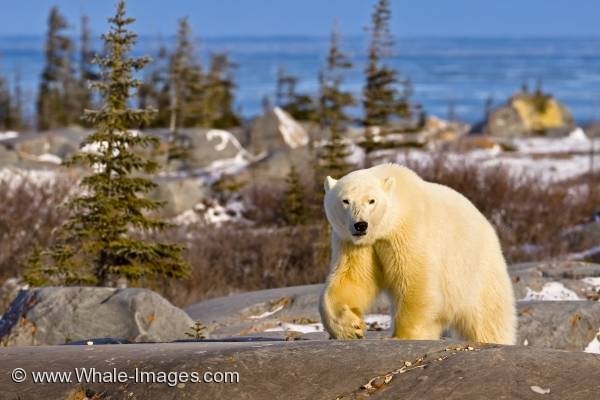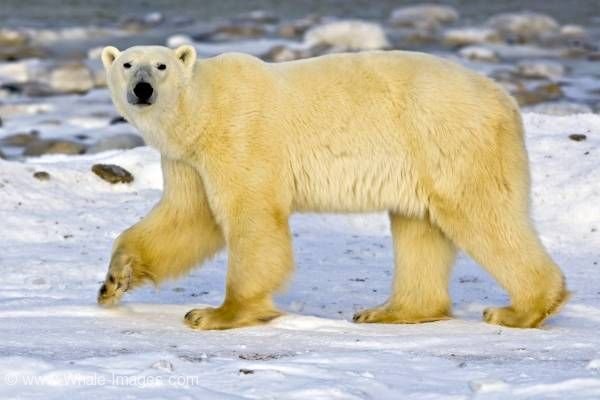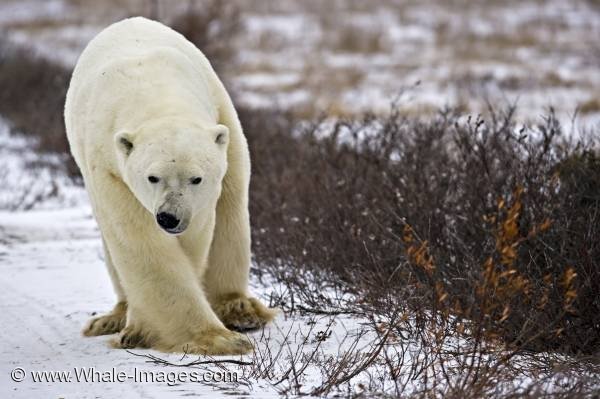Polar Bear Facts Information
Facts, information and pictures for the Polar Bear, Ursus maritimus.
Path: Animal Facts / Polar Bear Facts Information
Polar Bear
- Scientific Name: Ursus maritimus - Class: Mamalia - Family: Chordata
General Information:
Many names for the polar bear (here you can find our Polar Bear photos) exist amongst the peoples who live near it: Lord of the Arctic, God's Dog, Old Man in the Fur Cloak, White Bear, Ice Bear, Sea Bear, IsBjorn, even White Sea Deer as well as many others. The person who gave the scientific name of Ursus Maritimus to the polar bear was Constantine John Phipps, both an officer in the British Navy and an explorer. At the age of 30, he embarked on a voyage to the North Pole, but was forced back the autumn of the same year (1773) because of the ice. In his book, A Voyage to the North Pole, he describes the polar bear, its behaviour and its characteristics. Polar bears are the most recent of the eight bear species, emerging about 200,000 years ago and were much larger bears then than they are today. Polar bears (carniverous) and the kodiak bear (omniverous), are the largest bears on earth, being found in the Arctic Circle and adjacent land. They are magnificent animals, massive and powerful, and have no predators other than man and other polar bears.
Polar bear walking in beautiful landscape along the Hudson Bay near Churchill in Manitoba, Canada
To watch them on the snow is a very special experience. To see and be near an animal that is so exquisitely adapted to its environment strikes one with awe. Northern Canada is an excellent place to visit to experience the polar bear during the vacation of a lifetime.
Physical Characteristics
Polar bears have a body length of 180 to 250 centimetres (5 feet 11 inches to 8 feet 3 inches) and a shoulder height of 160 cm (5 feet 3 inches). The males weigh between 300 and 800 kilograms (660 pounds to 1760 pounds) and the females from 150 to 800 kilograms (330 pounds to 1760 pounds). A polar bear's legs are powerful and stocky and the feet are very large, about 30.5 centimeters (12 inches) in diameter, developed to aid in swimming, hunting and to walk on top of the snow or thin ice like snowshoes. Typically, polar bears would rather walk on snow than ice and their movements are slow and very deliberate. The feet also have small bumps of skin on the pads, giving the bear better traction on the ice. The claws are relatively short (5.1 cm or 2 inches) and thick, having deep indentations on the underside which help in digging and shovelling the ice and snow to form shelter for themselves or their cubs and in scooping seals from the water during hunting. The polar bear has a longer body than the brown bear and a longer head and snout. The neck is also long, enabling them to thrust their heads into seal's breathing holes easily. Their sheer mass is helpful to them in their cold native Arctic environment, helping to conserve heat since they lose the heat that is generated in their bodies more slowly than a smaller animal. The ears of the polar bear are round and small and the tail short, again helping them conserve heat. The aerodynamic shape of the head and body result in excellent swimming and diving ability, cutting through the water cleanly and with seemingly little effort. The nose and mouth are black, contrasting with their fur which, although white, is not a pure white; instead it is a creamy tone. The topcoat is comprised from coarse, hollow hairs known as guard hairs that keep the coat from matting down when they swim. The hollow hairs are unique to a polar bear's coat and along with the thick layer of fatty blubber protect their bodies from the icy water where they swim to catch their prey. The undercoat is soft and thick, insulating the bear from the cold. The sense of smell is very strong as are the senses of sight and hearing. The polar bear is a superb hunter and heightened senses have been developed in its barren-looking Arctic environment where, to man's eyes, ears and nose, not much life exists. According to research, a polar bear's IQ is level with that of an ape and their intelligence is evident both in their hunting skills which is learned behaviour and in their sense of play.
Habitat, Diet and Behaviour
Because they are linked inextricably to the sea in pursuing their food, the lives of polar bear are spent near or on pack ice. They usually stay within 180 miles of shore but have been known to drift with the ice well beyond that range. The species is found throughout the North of five countries: Canada, Denmark (Greenland), Norway, Russia and the United States (Alaska). The sea ice provides easy access to their prey and the bears must follow the sea ice to eat. They can wait patiently for hours at a seal's breathing hole for it to appear before attacking and scooping the seal onto the ice where they snatch the head in its jaws, crushing it. Polar bears eat mostly ringed and bearded seals and occasionally walrus. They do not drink but instead derive their required liquid from the animals they eat. After eating, polar bears clean themselves with snow or wash in the water. When food is plentiful, the bears eat only the skin and blubber of their seal kills, leaving the protein rich meat for the younger bears that have not yet developed good hunting skills. Beluga whales have also been recorded as prey by polar bears. The bears swipe at them with a gigantic paw at a breathing hole much like they do with a seal.
A cute Polar bear, which belongs to the endangered species, looks for food along the Hudson bay shoreline
On land, most terrestrial mammals can evade the polar bear by being faster and outrunning it as the bear quickly becomes over-heated and must stop. In the sea, most marine animals can evade the bear by outswimming it. The smaller size of the prey and its manoeuvreability work to their advantage. To survive, the bear has become an excellent hunter, either waiting at breathing holes for hours or even days or by slowly stalking its prey, crawling toward it inch by inch on the ice. Once seen, the bear freezes its motion, but as soon as the intended prey has lost the high alert status, the bear resumes its crawl; when within a few feet of its prey, the polar bear pounces and attacks before the seal can slip into the water. Polar bears that have become trapped on land in the summer can become opportunistic feeders and studies have found and photographed bears climbing nearly vertical cliffs to eat birds' eggs and chicks. Although polar bears can live off their fat reserves for months at a time, they also have been seen to eat crabs, rodents, reindeer, muskox and other polar bears when their normal food sources are not available. They may also eat plants but vegetation does not seem to be important in their diet. Curious animals by nature, when polar bears come near populations of humans, they will find the garbage dumps and will unfortunately consume styrofoam, car batteries, antifreeze, and motor oil. For this reason, the dump in Churchill, Manitoba was closed and replaced by a recycling station. Non-recyclables are trucked to Thompson, Manitoba. Although the bears are largely solitary animals, they have been observed sharing a single walrus carcass, eating side by side without conflict. Having made a kill, one bear usually "owns" a large carcass; however, if the other bears ask to share by the signs of submission, lowering their heads and bodies near the ground, circling the carcass and eventually even touching noses with the bear who is the "host" at the dinner party, there usually will be no objection and peace will reign.
The speed of a polar bear is about 5 to 6 kilometres per hour when walking; females with cubs perhaps move at half that speed. They are able to run very fast, as much as 40 kilometres per hour but only for short distances; the bear prefers to amble along at the slower pace. Their bodies use about twice the amount of energy as other animals in movement and the slower pace allows conservation of of energy since food resources are not plentiful nor easy to catch. Younger bears with less mass can run for as much as 2 kilometres without stopping.
In their sleeping habits, they are much like humans; they sleep for about 7 hours at a time and they also like to nap. In winter, they dig shallow depressions in the snow, place their backs to the wind and settle down to sleep or nap and in this way, they can sleep right through a blizzard. The snow forms an insulating blanket on top of them as it piles up during the storm. Polar bears do not hibernate like other bears but pregnant females, after feeding heavily to gain pounds as food reserves, dig what are known as two-roomed maternity dens in the autumn months, giving birth to their cubs in the winter. Mother and cubs sleep on and off until spring when the cubs are mature enough to travel with their mother. Until the spring, the mother is able to conserve her energy by reducing her metabolic rate, like they do when food is scarce. Mother polar bears give birth to two, sometimes three, cubs and the newborns weigh little more than a half kilogram (one pound) at birth and once they are old enough to emerge from the den, the mother takes them out on the pack ice where she can find food to replenish her own resources after not hunting for four to eight months. For nearly two years, the cubs drink the rich mother's milk and their survival depends on her totally. During this time, she is hunting both for her own nutritional needs and to teach the cubs the skills needed to hunt for themselves. In the high Arctic, the cubs remain with their mother for about three years; further down, for about two years.
A Polar bear waiting and looking for food in the arctic tundra for the Hudson Bay to freeze over
Polar bears have been assessed as having a high level of intelligence; for communicating with other bears, both body language and the vocalization of sounds are used. Having made a kill, one bear usually "owns" a large carcass; however, if the other bears ask to share by the signs of submission, lowering their heads and bodies near the ground, circling the carcass and eventually even touching noses with the bear who is the "host" at the dinner party, there usually will be no objection and peace will reign. Loud roars and growls not surprisingly signal anger to others. Deep growls are warnings for the other bear to retreat, used for instance in guarding a carcass. Lowering the head, hissing and snorting all are signs of aggression. When a mother bear has cubs and is approached by a male bear, she will charge the male with her head lowered and emitting "chuffing" sounds, worried about her cubs. Head wagging back and forth is a sign that the bear is asking another bear to play, although play often looks to us more like aggression since it simulates fighting. When a bear means business and attacks, its head is lowered and its ears laid back. Mother bears discipline their cubs with a quick cuff. Whether they are annoying their mother or their behaviour is dangerous to their own survival, the response by the mother is the same and the cub is sent rolling from one swipe of the mother bear's large paw.
Conservation
With eight of the nineteen populations of polar bear declining in numbers, the polar bear has now been classified as a vulnerable species. Declining populations at first were due largely to overhunting and when restrictions were placed on hunting through controls and quotas, there was a positive effect on their numbers. Now, climate change and global warming appear to be the enemy to the polar bear's survival; the melting of the sea ice that is occurring in the Arctic reduces the bear's habitat for hunting for it lives most of its life on the drifting sea ice. The International Union for Conservation and Nature has predicted that if the sea habitat continues to melt, polar bears may become exterminated from most of their range within 100 years. Whether they could adapt and survive in another environment is a question for the future but the answer right now is probably not.
The terminology used to describe the state of the polar bears' status as a species in the different countries where the polar bear resides differs, but the meaning is about the same. In Canada, the bear is described as a species of special concern; in the United States, it is listed as a threatened species under the Endangered Species Act; Russia also considers the polar bear to be a speciies of special concern. Ranging from Russia to Alaska, from Greenland to Canada, and onto Norway's archipelago, the polar bear obviously becomes the concern of many nations. Scientists estimate that they number about 20,000 to 25,000 bears with approximately 60 per cent of those bears living in Canada and are almost unanimous in concluding that the loss of their habitat, especially their summer habitat is their greatest concern. Climate change has resulted in a vast area of summer ice being lost to melting, an area that is larger than the Canadian provinces of British Columbia, Alberta, and Saskatchewan combined.
On November 15, 1973, the International Agreement on the Conservation of Polar Bears was signed in Oslo, Norway by Canada, Denmark, Norway, the United States of America and the former U.S.S.R. Hailed as one of the first and most successful international conservation agreements of the 20th century, the agreement: prohibits random, unregulated sport hunting of polar bears; outlaws hunting from aircraft and icebreakers; requires each country to protect the denning areas and migratory areas of the polar bear; obliges the signatory countries to research the conservation and management of polar bears and to share the research findings with others. Today, scientists from the signatory countries continue to work together and have introduced new areas of study such as industrial activities, pollution, climate change and poaching. Under the International Union for Conservation and Nature, they meet every three or four years to coordinate their research and discuss new areas of endeavour. This research and cooperation is likely the largest hope we have for the survival of the polar bear species.
The famous Polar bear tours from Churchill, Manitoba with the arctic Tundra Buggy
Ecotourism
The polar bear is an important animal to the Inuit and other indiginous peoples of the north, not only because of its economic uses but also because of its spiritual significance in their culture. Hunts continue to take place today. The polar bear is a solitary animal, except for the females with cubs and when they are near abundant food sources. In Canada, for a few weeks, the polar bear gather at Churchill, Manitoba, to await the formation of the ice in Hudson's Bay, when they can go out again to live and to hunt. In Canada, you can stay at a hotel and travel out to see the bears daily or live in a remote wilderness cabin or even aboard a mobile tundra buggy lodge, surrounded by the bears, a unique experience and a trip of a lifetime to encounter a species so perfectly evolved that few people have the opportunity to observe. Organizations that work to conserve and preserve endangered species believe that when people see the polar bear, they will understand the need to save it and they will want to save it. Respectful and carefully thought-through ecotourism helps local people earn income and since they share the habitat with the bear, they are encouraged to conserve the habitat of the polar bear and themselves. Responsible ecotour companies do not want to harm the polar bears. On an ecotour of the polar bears' habitat, every level of luxury from comfortable to abundant to indulgent exists and the food encountered will vary from camp food to gourmet. Canada is an excellent place to begin your experience to learn about the polar bear and to become an advocate for its survival.
Keywords
- page
- Animal Facts (9)




